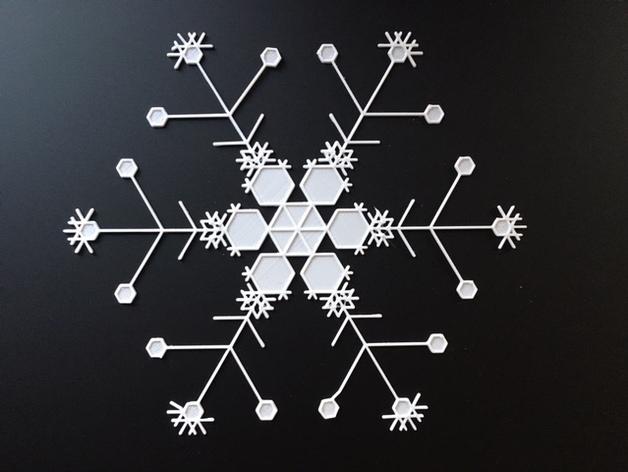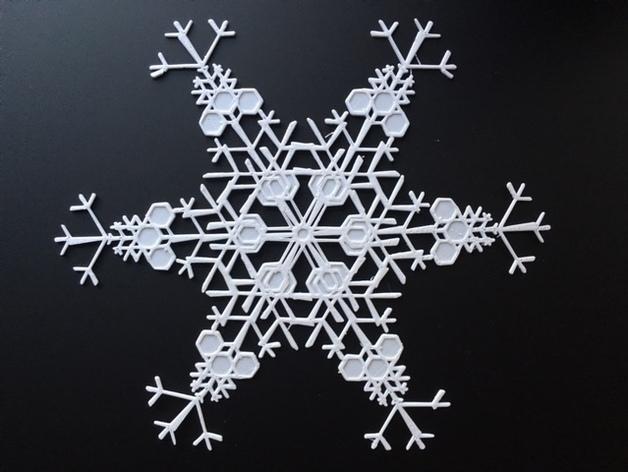 I recently found a large pink-glittered snowflake decoration on the street that now graces my apartment door for the holiday season, and it reminded me about how miraculous snowflakes really are. Do you remember first learning as a child that no two snowflakes are the same? Now we can take that lesson one step further and talk about how no two 3D printed snowflakes decorations will ever be the same now that we have the amazing Snowflake Machine from Professor Laura Taalman, aka mathgrrl. We’ve covered the work of Dr. Taalman and her students before. Her latest design is flaky–but in the excellent sense of the word. She’s figured out how to combine an impressive knowledge of “random numbers, mathematical algorithms, computer code, and SCIENCE to create well over a billion unique and beautiful snowflakes.” Just take a moment to think about that…now let’s proceed.
I recently found a large pink-glittered snowflake decoration on the street that now graces my apartment door for the holiday season, and it reminded me about how miraculous snowflakes really are. Do you remember first learning as a child that no two snowflakes are the same? Now we can take that lesson one step further and talk about how no two 3D printed snowflakes decorations will ever be the same now that we have the amazing Snowflake Machine from Professor Laura Taalman, aka mathgrrl. We’ve covered the work of Dr. Taalman and her students before. Her latest design is flaky–but in the excellent sense of the word. She’s figured out how to combine an impressive knowledge of “random numbers, mathematical algorithms, computer code, and SCIENCE to create well over a billion unique and beautiful snowflakes.” Just take a moment to think about that…now let’s proceed.
The Machine does several things. It generates 3D printable snowflake patterns using a random number seed; it uses sliders to control your snowflake’s style in ten different ways; and it creates different sized snowflake decorations, like giant detailed snowflakes or micro-sized snowflakes (if you have an ultra-fine nozzle). Wow. Flaky indeed.
 How does it work? Well, on the Snowflake Machine Thingiverse page, there’s a button that reads “Open in Customizer.” Click on that. Then choose your seed and style setting and click “Create Thing.” You have to wait a few minutes for snowflake magic to happen. Next, reload your List of Things until new snowflake designs appear. Now download and print your unique snowflakes.
How does it work? Well, on the Snowflake Machine Thingiverse page, there’s a button that reads “Open in Customizer.” Click on that. Then choose your seed and style setting and click “Create Thing.” You have to wait a few minutes for snowflake magic to happen. Next, reload your List of Things until new snowflake designs appear. Now download and print your unique snowflakes.
Dr. Taalman wants to make sure you photograph and post these original designs so she’ll know when the one billionth original snowflake has been 3D printed. Okay, that’s not why, but if you were the one who made the Snowflake Machine, you’d want to see them all, right?
 Now, I like to keep a little mystery going in my easy living among the more science and math-minded geeks. But you may want to know how this machine actually works: you know, what’s behind the scenes here? Well, Dr. Taalman is kind enough to explain it in layperson’s terms. Generally, the Machine generates patterns using an algorithm that mimics the way snowflakes grow in real life. You see, snowflakes begin their lives as hexagonal prism seeds growing outward with branches and plates. The placement and size of these branches are determined by atmospheric temperature and humidity. If you think about it, the reason no two snowflakes are ever the same is that each moment of a snowflake’s crystallization is an original moment in the atmosphere for the particles and environmental factors that are combining. This creates something miraculously unique. Again. Pause. Wow.
Now, I like to keep a little mystery going in my easy living among the more science and math-minded geeks. But you may want to know how this machine actually works: you know, what’s behind the scenes here? Well, Dr. Taalman is kind enough to explain it in layperson’s terms. Generally, the Machine generates patterns using an algorithm that mimics the way snowflakes grow in real life. You see, snowflakes begin their lives as hexagonal prism seeds growing outward with branches and plates. The placement and size of these branches are determined by atmospheric temperature and humidity. If you think about it, the reason no two snowflakes are ever the same is that each moment of a snowflake’s crystallization is an original moment in the atmosphere for the particles and environmental factors that are combining. This creates something miraculously unique. Again. Pause. Wow.
Dr. Taalman goes on to explain:
“To mimic this process, the OpenSCAD code behind the Snowflake Machine generates sequences of random numbers based on a random seed that you select, and then grows a snowflake design by adding branches or plates in each step. The random number sequences and the style parameters whose values you select with the Customizer sliders act like the temperature and humidity of the air around the snowflake, making it more or less likely that different formations will be generated.”
That actually makes sense, too! We learn something new every day, huh?
Now that we are all caught up on the science of snowflake formation, isn’t it about time you fire up your printer, open up your Thingiverse Customizers, and start generating those snowflake patterns for everyone to enjoy this holiday season? I think these would look cool just hanging around any time of the year. Discuss this story in the 3D Printed Snowflake forum thread on 3DPB.com.
Subscribe to Our Email Newsletter
Stay up-to-date on all the latest news from the 3D printing industry and receive information and offers from third party vendors.
You May Also Like
3D Printing Unpeeled: Wind Turbines, Probiotics and Lenses
TPI Composites, ORNL and Ingersoll Rand are working to make wind turbine tooling segments that can be 18.3 meters long. These elements also include resistive wires that help keep the...
3D Printing Unpeeled: Digital FDM Filament for Functional Gradients
Just published in Nature, a paper by a Seoul National University team looks at “3D printing with a 3D printed digital material filament for programming functional gradients.” Sang-Joon Ahn, Howon...
3D Printing Unpeeled: $5000 Cold Spray 3D Printer, Roland DGA & Living Materials
The AeroForge is a $5000 cold spray metal printer for copper made by a student team at Rice University. In a paper for ACS Central Science a team from Nanjing...
3D Printing Webinar and Event Roundup: April 28, 2024
In this week’s 3D Printing Webinar and Event Roundup, the Ceramics Expo is taking place in Michigan, Stratasys continues its advanced training courses, and SPE is holding a Polymer Characterization...
































